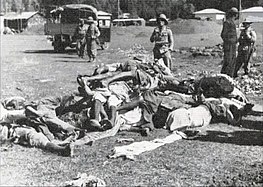Addis Ababa Massacre
The Addis Ababa massacre , also known as the Addis Ababa pogrom , describes the violent riots against the inhabitants of Addis Ababa that lasted from February 19 to 21, 1937 during the occupation of fascist Italy . On the one hand, they included a general persecution of the black majority population, which manifested itself in indiscriminate mass executions , severe abuse, large-scale looting and the burning of around 4,000 houses at night . On the other hand, the fascists also pursued a targeted and systematic murder of the urban educated class. In Ethiopia , the events after their start date in the Ethiopian calendar are commonly known as Yekatit 12 ( Amharic የካቲት ፲፪ ).
The reason for the pogrom was a failed attempt to assassinate the fascist viceroy Rodolfo Graziani . On February 19, he invited around 3,000 townspeople to his residence to celebrate the birth of the first son of the Italian heir to the throne Umberto of Savoy . During the ceremony, two members of the Ethiopian resistance movement threw nine grenades at the highest representatives of the Italian occupation forces, seriously injuring Viceroy Graziani. Shortly afterwards, the Italian soldiers present opened fire on the assembled crowd with machine guns. The palace grounds were cordoned off by the military, and almost all Ethiopians present perished there. Subsequently, the local fascist party secretary Guido Cortese gave the 6th Black Shirt Division a three-day license for “retaliatory actions” against the black civilian population who were collectively held responsible for the attempted assassination by the fascists. In the days that followed, Ethiopian civilians were shot and hanged en masse, but also beaten to death with clubs, shovels or pitchforks, drowned in the river or burned alive by flamethrowers in their huts - including a disproportionate number of women and children.
The driving force behind the excesses of violence were the fascist militiamen, but members of the Carabinieri , the military, Italian settlers and colonial troops also took part in the pogrom. The total number of massacre victims is the subject of scientific debate due to the patchy research that has been carried out to date. While the Ethiopian authorities reported 30,000 deaths after the Second World War , Italian historians believe that 3,000 to 6,000 deaths are credible. The British historian Ian Campbell, who published the first comprehensive account of the massacre in 2017, estimates the total number of victims in his case study at 19,200 people, which would have meant that Addis Ababa would have lost 19 to 20% of its population in just three days. Campbell's estimate does not take into account those Ethiopians who died as a result of injuries after the massacre or who died during their subsequent internment in the Danane and Nocra concentration camps .
- Victims of the massacre
Web links
- Italy and the Addis Ababa massacre. In: economist.com, July 20, 2017, accessed July 11, 2020.
literature
- Ian Campbell: The Addis Ababa Massacre: Italy's National Shame. Hust & Company, London 2017, ISBN 978-1-84904-692-3 .
- Angelo Del Boca: The Ethiopian War 1935-1941. The University of Chicago Press, Chicago / London 1969.
- Aram Mattioli : A Forgotten Key Event of the World War II. In: Asfa-Wossen Asserate , Aram Mattioli (ed.): The first fascist war of annihilation. The Italian aggression against Ethiopia 1935–1941 (= Italy in modern times. Vol. 13). SH-Verlag, Cologne 2006, ISBN 3-89498-162-8 , pp. 9-26.
- Aram Mattioli: Experimental field of violence. The Abyssinian War and its international significance 1935–1941 (= culture - philosophy - history. Volume 3). With a foreword by Angelo Del Boca. Orell Füssli, Zurich 2005, ISBN 3-280-06062-1 .
- Alberto Sbacchi: Ethiopian Opposition to Italian Rule, 1936–1940. In: ders .: Legacy of Bitterness: Ethiopia and Fascist Italy, 1935–1941. The Red Sea Press, Lawrenceville 1997 [1978], ISBN 978-0932415745 , pp. 165-204.



